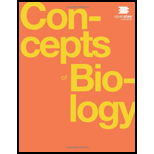Solutions for Concepts of Biology
Problem 1ACQ:
Figure 11.7 Do you think genetic drift would happen more quickly on an island or on the mainland?Problem 2RQ:
Which scientific concept did Charles Darwin and Alfred Wallace independently discover? a. mutation...Problem 3RQ:
Which of the following situations will lead to natural selection? a. The seeds of two plants land...Problem 4RQ:
What is the difference between micro- and macroevolution? a. Microevolution describes the evolution...Problem 5RQ:
Population genetics is the study of ________. a. how allele frequencies in a population change over...Problem 6RQ:
Galapagos medium ground finches are found on Santa Cruz and San Cristóbal islands, which are...Problem 7RQ:
In which of the following pairs do both evolutionary processes introduce new genetic variation into...Problem 8RQ:
The wing of a bird and the arm of a human are examples of ______. a. vestigial structures b....Problem 9RQ:
The fact that DNA sequences are more similar in more closely related organisms is evidence of what?...Problem 10RQ:
Which situation would most likely lead to allopatric speciation? a. A flood causes the formation of...Problem 11RQ:
What is the main difference between dispersal and vicariance? a. One leads to allopatric speciation,...Problem 12RQ:
Which variable increases the likelihood of allopatric speciation taking place more quickly? a. lower...Problem 13RQ:
The word “theory” in theory of evolution is best replaced by______. a. fact b. hypothesis c. idea d....Problem 14RQ:
Why are alternative scientific theories to evolution not taught in public school? a. more theories...Problem 15CTQ:
If a person scatters a handful of plant seeds from one species in an area, how would natural...Problem 16CTQ:
Explain the Hardy-Weinberg principle of equilibrium.Problem 17CTQ:
Describe natural selection and give an example of natural selection at work in a population.Problem 20CTQ:
Two species of fish had recently undergone sympatric speciation. The males of each species had a...Browse All Chapters of This Textbook
Chapter 1 - Introduction To BiologyChapter 2 - Chemistry Of LifeChapter 3 - Cell Structure And FunctionChapter 4 - How Cells Obtain EnergyChapter 5 - PhotosynthesisChapter 6 - Reproduction At The Cellular LevelChapter 7 - The Cellular Basis Of InheritanceChapter 8 - Patterns Of InheritanceChapter 9 - Molecular BiologyChapter 10 - Biotechnology
Chapter 11 - Evolution And Its ProcessesChapter 12 - Diversity Of LifeChapter 13 - Diversity Of Microbes, Fungi, And ProtistsChapter 14 - Diversity Of PlantsChapter 15 - Diversity Of AnimalsChapter 16 - The Body's SystemChapter 17 - The Immune System And DiseaseChapter 18 - Animal Reproduction And DevelopmentChapter 19 - Population And Community EcologyChapter 20 - Ecosystems And The BiosphereChapter 21 - Conservation And Biodiversity
Book Details
Concepts of Biology is designed for the introductory biology course for nonmajors taught at most two- and four-year colleges. The scope, sequence, and level of the program are designed to match typical course syllabi in the market. Concepts of Biology includes interesting applications, features a rich art program, and conveys the major themes of biology.
Sample Solutions for this Textbook
We offer sample solutions for Concepts of Biology homework problems. See examples below:
More Editions of This Book
Corresponding editions of this textbook are also available below:
CONCEPTS OF BIOLOGY
13th Edition
ISBN: 2810014143673
CONCEPTS OF BIOLOGY
17th Edition
ISBN: 9781947172036
Related Biology Textbooks with Solutions
Still sussing out bartleby
Check out a sample textbook solution.
